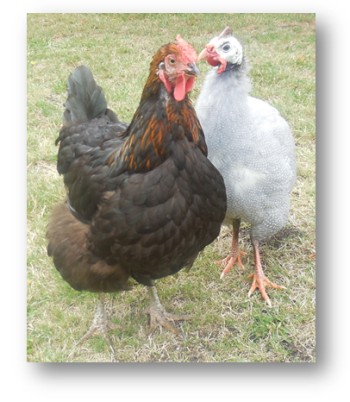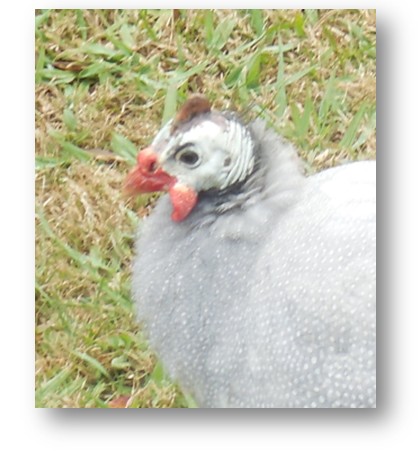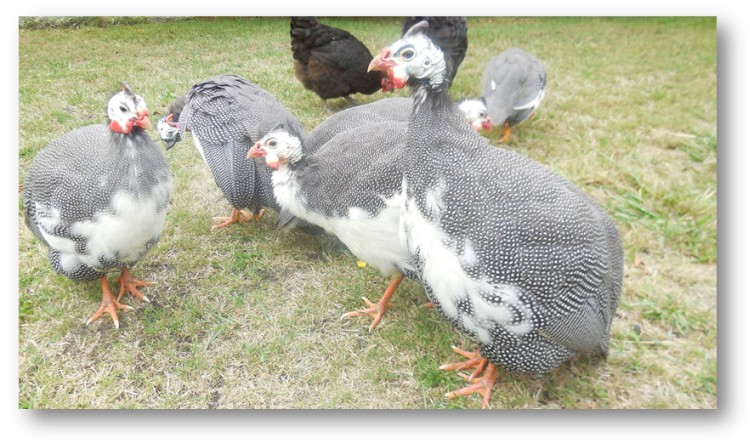
 “Mum, what are those strange looking birds?”
“Mum, what are those strange looking birds?”
“Which one’s darling?”
“Look, over there! It’s got a funny looking ‘thing’ on the top of its head! Its neck is all wrinkly! What is it mum?”
Don’t worry mum… or dad, I’m here to help you. You see, I consider myself most fortunate to own some of these ‘funny looking birds’!
In this article on how we care for Guinea Fowl facts I will give insight into the strange and unusual.
xxx
- How to Raise Guinea Fowl Keets (up to 8 weeks old)
- Care for Guinea Fowl Facts – Part 2 (facts and features) – this page!
- Care for Guinea Fowl Facts – Part 3 (facts and stories)
How we come to have Guinea Fowls
We moved to a 2.5 acre property in Tasmania which was totally devoid of animal and bird life. Oh there were plenty of wild birds and animal wildlife, such as wallabies, rabbits, bandicoots and such… but I wanted to add some of our own birds and animals.
Within a week my son (Trent) bought a dog; on the second week we purchased some ducks to swim on our dam. About the same time, Trent’s horse arrived after being transported from NSW.
Moving on we purchased 6 chooks (chickens) and 1 rooster. The hens were just coming in to lay. So our property was coming together with all this lovely life around and about… yay! It felt good.
Meanwhile I began reading about Guinea Fowl online. What interesting birds, I thought. I’d really like to have some of those.
But for now… let’s fast forward until my 7 Guinea Fowl are about 6 months old…actually, more like 7 months. Oh how times flies!
Guinea Fowl young are called keets and that’s what we still call them. They are actually fully grown by around 6 months but we find it easier to say “keets” than Guinea Fowl! We’re lazy!
Apparently from all I’ve learned about Guinea Fowl egg-laying, is that they should be laying right now, but as we are in mid-winter, I guess it’s too cold. From that I would suspect it may be Spring before I can expect to find eggs. At this stage I have no reason to believe there is any egg-laying going on, as I don’t ever see one of the girls missing. The ducks and chooks are still coming on to lay since their last molt. When that’s completely over they should get back to the serious business of laying again.
Guinea Hens are not good mums
 Guinea Hens do not make good mothers unfortunately, and as I’ve observed the way these birds carry on, I can easily imagine why. This particular information is not coming from my personal experience as we had a hen raise our brood. Let me say right now that the black chook (called White Feather) who went broody just in time to sit on these eggs, made a marvellous mum. We couldn’t fault her in any way. She was brilliant.
Guinea Hens do not make good mothers unfortunately, and as I’ve observed the way these birds carry on, I can easily imagine why. This particular information is not coming from my personal experience as we had a hen raise our brood. Let me say right now that the black chook (called White Feather) who went broody just in time to sit on these eggs, made a marvellous mum. We couldn’t fault her in any way. She was brilliant.
BTW… White Feather is so called because she had some teeny wheeny white feathers on the back of her head. We laugh about that now because since the molt she’s got quite a lot more, and some lovely white tips on some of her other feathers. We tell her she went grey bringing up all the kids!
Anyway, back to why Guinea Hens don’t make good mothers. The main reason is because they are always in a rush. Everything must be done quickly. Apparently they rush across the wet grass with the poor little babies struggling to keep up… In the end they get wet from the dew or rain and end up dying. A sad outcome.
Personally, if I were using a Guinea Hen to raise more keets, I wouldn’t allow them outside until they were 8 weeks old. At least, that would be the plan. From what I’ve read though, Guinea Hens, being pretty much a wild bird, make nests all over the place and not in the nests you provide… and it’s not so easy to move them. Oh well, at this stage we only hope to collect the eggs as we don’t really want any more.
 Young Pied. The one with the white neck is a female.
Young Pied. The one with the white neck is a female.
Helmeted Guinea Fowl
– In General
Guinea Fowl keets are born absolutely cute and adorable and all mine, barring one, were covered in varying stripy brown colours. But as they grow they begin to take on a completely different look. Would you call them cute and adorable then? Well, not really. The feathers fall off their faces and heads and are replaced by a tough looking brilliant white skin. The helmet pushes through which looks rather unusual together with the wattles on the side of their faces.
There is a distinct black line above the eyes that to me looks like they’ve applied eyeliner before going out for the day! On closer inspection I believe it’s an eyebrow.
When they are very young they are fairly delicate. You need to be very careful never to pick them up by their legs as they are easily broken. I know some people say you must keep them in a really warm temperature as they can easily die if they get cold. I wouldn’t say it was all that warm when they come into the world, but neither was it cold. Apparently White Feather did a very good job of keeping them nice and snug under her wings as we didn’t lose any.
Once they grow though they are an extremely hardy bird with little to none diseases to worry about.
As babies they were amazing tiny, but what I did notice was they were in a rush to grow up, at least as far as how they looked. They were fully feathered and able to fly at only 2 weeks of age. As I mentioned in How to Raise Guinea Fowl Keets, Little Duckie at that age was covered in yellow down… not a white feather in sight!
– Helmet
My birds are known as Helmeted Guinea Fowl because they have that ‘funny’ thing on the top of their head. As baby keets they have little soft feathers but as they grow the nob begins to show through. By the time they are 6 months old, it is quite pronounced.

For a long time you cannot tell which is a female or a male just by looking at them. Their little helmet grows about the same and there’s nothing to distinguish them by, but certainly by the time they are 6 months old, the male’s helmet is taller and more upright. The female’s tends to slant backwards a little more and is smaller.
I also noticed the colour changed from grey to red once they were fully grown.
– Wattles
As they grew, the wattles on the side of their faces grew more and more pronounced. Some of them are fairly even, while others have one different to the other. The wattles on the male are slightly more cupped than the female but you’ve got to look closely to see the difference.
– Sex
Of the seven keets, only two are females and oddly enough they are almost like identical twins. The white on their front continues right up the front of their neck, both in the same fashion. You have to look really very closely to be able to tell which one is which.
Right from when they were born I was able to distinguish male from female, because I used a method for sexing that I find works every time. Just by using a nail hanging on the end of a piece of string. It swings one way for female and another for male.
– Communication
When they were young they all made the same sound… just a gentle chirping sound which has stayed with them as they grew. They use these chirps to communicate with each other – a lovely contented sound.
I’m not 100% sure when their individual sounds came through, I wish I had taken more notice. But as the months pass, the girls develop a two-syllable sound which they like to use often. You really do have to become used to it. The males have a one-syllable sound which they use infrequently. They are actually easier to live with. Both males and females use the same one-syllable sound when they are alarmed… loudly and all together.
I’ve got used to it and generally it doesn’t annoy me, but my menfolk find the females a bit hard to deal with at times. It’s quite loud and seemingly endless. Sometimes they like to get up onto the railing of the verandah, or on top of the shed or garage, anywhere that’s up… and do their endless cry. We’ve not been able to work out why they do it as there doesn’t appear to be any apparent reason. Fortunately the boys don’t do it and their singular sound is only used briefly. But this singular sound becomes the chortling sound (alarm), which they do loudly in unison, girls included making the same sound. It stops just as soon as the “alarm” passes.
– Types
I have 3 different types of birds:
1 Lavender – a soft silver lavender colour with white spots.
1 Pearl Grey – All deep grey with white spots
5 Pied – Grey with white chests, or chests and front of necks, with white spots.
When flying, they all display striking white flight feathers which on gliding in to land they tuck away to keep them nice and clean.
– Mating Rights
 Early in the piece all the birds decided Lavender was different to them and run him off. I was as saddened by this, as he was. It’s not fun when all your siblings pick on you, but pick on him they surely did.
Early in the piece all the birds decided Lavender was different to them and run him off. I was as saddened by this, as he was. It’s not fun when all your siblings pick on you, but pick on him they surely did.
For a little while he seemed to have no friends but he’s struck up some very close friendships with the chooks. He now prefers to be with them, rather than with the other keets. It’s just too hard as they insist on chasing him. When all the birds are together he’s there in the midst of them, but when it’s just keets he’s definitely the odd man out. He still wanders with the flock but chooses in most cases to stay with the hens or the rooster.
This is not his mum, but one of his ‘aunties’… looking a bit straggly as she’s going through the molt. It’s lovely to see how accepting the chooks are of the keets in most cases. When it comes to who sits where on the roost the chooks seem to win the day… being bigger I suppose. I have never seen a keet peck a chook, only each other if something upsets them.
Earning your mating rights is a very serious business. These birds had been fighting for about 2 hours. Most of it was just chasing each other but you can see here they were getting into the more serious stuff. As I watched them I saw that Lavender seemed to be the more determined. I thought to myself it was all his months of rejection by his siblings coming out in him!
You can hear the female complaining bitterly about all this fighting! She ran into them a few times to try to get them to stop, but they figured they had a job to do. Fortunately they settled down and seem to live peaceably together now.
What is not too good is the fact that we have 5 males and only 2 females. I guess the right ratio would be 1 male and 2 females, but that would mean 4 would have to go. Not sure where they would go to. Anyway, we’ve just left it for now and will deal with it if we run into problems.
– Eggs
The eggs of the Guinea Hen are quite small, I guess about half the size of a normal average chicken egg. They are a different shape too being more pointy in shape. Now I haven’t experienced eggs here yet but I do know what the eggs looked like that our hen hatched out for us. I’ve not yet broken one, but I believe they are pretty tough and the egg to egg white ratio is more similar to a duck. That means, the yolk is generally a larger portion than the amount of white.
Are you learning anything new? Do you have any questions you’d like to ask? Feel free to leave a message for me down below and I’ll be back to answer you just as soon as I can.
I hope Care for Guinea Fowl Facts – Part 2 has helped you to understand about these wonderful birds. Did you miss How to Raise Guinea Fowl Keets? If so, go catch up it now… I have lots of videos and visuals to inform you exactly what happened each step of the way.
Warm regards,

Marilyn Williams
![]()







Cool birds! I love reading this stuff because I’m a bird lover. Wish I lived somewhere where I could have them. Are they easy to care for?
I suppose it depends what you call easy. I originally received my first batch of keets from using a hen to hatch them, Nov 12 months ago and even month has been a learning experience from that point on. I can only write about what I’ve experienced. At this point in time we are going through the breeding season with them. A guy told me once that’s over we’ll be into yet another phase. I guess it’s live it and learn it. I do have a bit of sorting out with some of their squabbles etc, but to me it’s all basically fun. They are real birds with real personalities and it’s wonderful when you can come along side them and learn what they are thinking and doing.
I didn’t evenn know birds like this existed but thanks to you I now have ann understanding and idea. They sound so cute… can you cuddle themm?
No, they are not birds that respond to human touch very much. I’ve got one who will eat out of my hand… he’ll even chase me around the yard to see if I’ve got some goody in my hand. I’ve been able to give him a pat or two, but basically they don’t like it.
Thank you very, very much for this great and useful information and website. It is great info, well written with nice detail.
I appreciate all your hard work and time that went into this. I really do as it has become so useful already I have a short cut on my pin board.
I have already learned lot and I literally just opened it not a second ago.
This is outstandingly easy to understand and very informative.
Awesome!
I love this site it is truly one of a kind.
Thanks,
Market Merchant (MM+)
Thanks MM for your kind comments, I really appreciate it.
Thank you very, very much for this great and useful information and website. It is great info, well written with nice detail.
I appreciate all your hard work and time that went into this. I really do as it has become so useful already I have a short cut on my pin board.
I have already learned lot and I literally just opened it not a second ago.
This is outstandingly easy to understand and very informative.
Awesome!
I love this site it is truly one of a kind.
Thanks,
Market Merchant (MM+)
Thanks MM for your kind comments, I really appreciate it.
Guineas are such a funny lot! at our old house we had some that did an over bit of wondering. The first thing everybody noticed was the incredible racket going on outside. Next thing all the neighbors were out looking to see what was happening….and there they were, about a dozen of them walking down the lane. You are so right about the racket!!! Here in the states, in New Jersey they are very helpful with tick control. (which causes lymes disease here and a big problem)
Haha… that’s funny! You know, I’ve since learned that they are not always like that. When they are preparing for the mating season… at least the first time (can’t talk about any others yet as I haven’t experienced it), they are very noisy. One they settle who’s mate belongs to who they are so quite you don’t hear a thing from them.
Guineas are such a funny lot! at our old house we had some that did an over bit of wondering. The first thing everybody noticed was the incredible racket going on outside. Next thing all the neighbors were out looking to see what was happening….and there they were, about a dozen of them walking down the lane. You are so right about the racket!!! Here in the states, in New Jersey they are very helpful with tick control. (which causes lymes disease here and a big problem)
Haha… that’s funny! You know, I’ve since learned that they are not always like that. When they are preparing for the mating season… at least the first time (can’t talk about any others yet as I haven’t experienced it), they are very noisy. One they settle who’s mate belongs to who they are so quite you don’t hear a thing from them.
Hello Marilyn, sure mating rights is a big business for these birds. It is a sad thing to note that you can’t keep all the males and that four of them have to go.
I know who will stay, this is not rocket science. Lavender will stay, because of your emotional attachment to the bird.
You are doing a good job with these birds, keep it up.
Thanks Emmanuel! At this stage we’ve not felt we need to do anything about the keets as they are all getting along fine. There has only ever been that one time when there was a fairly major fight, I’ve not seen any other. We’ll take it day by day and see what happens.
You are right about Lavender, although one of the other males has begun sitting on my hand when I give them some sprouted wheat in the early afternoon. He let’s me pat him and is really cute. We’ll see.
Thanks for leaving your thoughts…
Very interesting birds guinea fowl are, you have a lot of interesting facts about them. They are very funny and strange looking birds.
You say they are not good mothers does this meant that the babies have a low survival rate?
Are these birds good to eat or there eggs, and if not what good are they for?
Yes they are fairly strange aren’t they! Someone came recently to our place and said “What is that?” when they keets climbed up on the back deck. We are so used to them that we don’t see their peculiarities any more.
The meaning of them not being good mothers is that the survival rate is very low because the mothers don’t know how to adjust themselves to their little babies. They are very fast runners and they fly from 2 weeks of age. They cross streams etc without thinking as to whether their babies can do it too. The little keets have a hard time keeping up. Another problem apparently is that they lead their little ones through wet grass which causes them to get pneumonia and die.
To offset this, they lay a lot of eggs before sitting. Upwards of 30 or so.
I’m told they are great eating but I will never know that from my own birds. No way! But, I hope to appreciate their eggs once they begin to lay. I’m told they are really delicious but as my birds are not laying yet, I’ve never tasted one.
The main reason I wanted to raise some Guinea Fowl was because they are great watchdogs. Only this morning a big brown dog was on the other side of our fence. Where were the keets? Oh, right up against that fence giving the dog the “what for’s”! They let you know when there is anything strange around, or unusual. They are a very brave bird who will attack even snacks, or at the very least, drive them off your property. I didn’t get them for meat or even eggs as we get plenty of those from our chickens/chooks and ducks. I was just impressed by their watch dog activities.
Thanks for your feedback – I really appreciate it. 🙂
We live in the a fairly small town in the US and it is against the laws to have chickens withjin city limits. With that being said my husband can’t help picking up a few chickens around Easter to enjoy with the kids. After a fer weeks (because they grow to fast!! ) we give them to a friend who lives in the country. He has a coop and we get eggs now and then. Reading your article gave me an idea of what they look like as adults now, becauase I never really have the chance to see them as adults.
What a lovely idea your husband has for your kids! I think that’s fantastic. A few baby chickens around couldn’t hurt anybody… even as adults chooks/fowls/chickens are very quiet birds so I don’t know why your city objects to them. On the other hand, I can easily understand why they wouldn’t want you to keep keets/Guinea Fowl as they are noisy. I will be doing an article on chickens soon. I appreciate your feedback. 🙂
What an interesting article – I had heard of these types of birds before but I was unaware of how popular they actually were.
You say that you were already looking after chicks etc in a coop situation ( I guess! ). Are these birds similar to look after? Are they actually more work in the log run?
To tell you the truth Chris, it’s a long time since I raised baby chicks so I couldn’t honestly tell you one way or another. I know back then that I didn’t have that much to do with it… the hen seemed to naturally do everything. But I’m much more involved with these birds and raising the keets was a lot of fun.
Thanks, I really enjoyed your post. I knew exactly what a guinea fowl is as we have plenty of them running around wild. I see them every day at my house. However I never really knew anything about them until I stumbled across your post.
They’ve always just been there and I haven’t given them another thought.
PS we are in South Africa and in any semi-rural to rural area you will find loads of them!
Funny isn’t it Lynne that what to you is everyday, to us is something quite special! Still, look what you did learn about them by reading my article… haha… that’s great!
Thanks for the comment, I really enjoyed it.